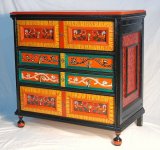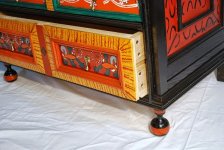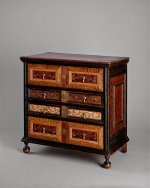zdillinger
Well-known member
This won't be everyone's cup of tea, but I love this kind of stuff. This chest of drawers is an exact replica of a c.1720 Eastern Massachussetts piece in the collection of the Met. I worked closely with curatorial staff and the conservator who worked on the piece in the 90s to get chemical analysis, construction photos, etc. to make this as spot on as possible.
This is a bit of a departure for me as I usually strive to make new furniture look as old as possible. With this piece, the interesting nature of the decoration would be lost if I did any aging to the finish, so I chose to replicate what it would have looked like when first made.
I realize most people today think this is gaudy, but when you remember the original context of low light conditions, it fits right in. Stuff in the period was often a lot brighter than we think today.... and this piece is certainly no exception. The original has muted and faded out to various shades of brown and yellow but the original pigments were quite bright!
Anyhow, here is how the original as it looked in 1997 (when the photos were taken), and how my piece looks (I just finished it last night).
Not a dovetail or glue bottle in sight but still a neat piece.
Thanks for looking.
Zach
This is a bit of a departure for me as I usually strive to make new furniture look as old as possible. With this piece, the interesting nature of the decoration would be lost if I did any aging to the finish, so I chose to replicate what it would have looked like when first made.
I realize most people today think this is gaudy, but when you remember the original context of low light conditions, it fits right in. Stuff in the period was often a lot brighter than we think today.... and this piece is certainly no exception. The original has muted and faded out to various shades of brown and yellow but the original pigments were quite bright!
Anyhow, here is how the original as it looked in 1997 (when the photos were taken), and how my piece looks (I just finished it last night).
Not a dovetail or glue bottle in sight but still a neat piece.
Thanks for looking.
Zach



